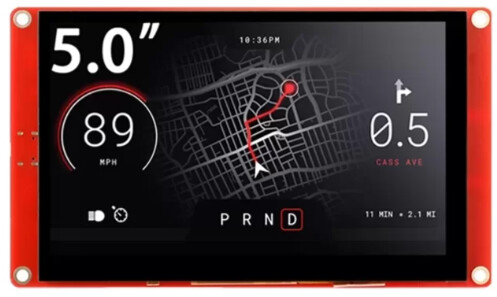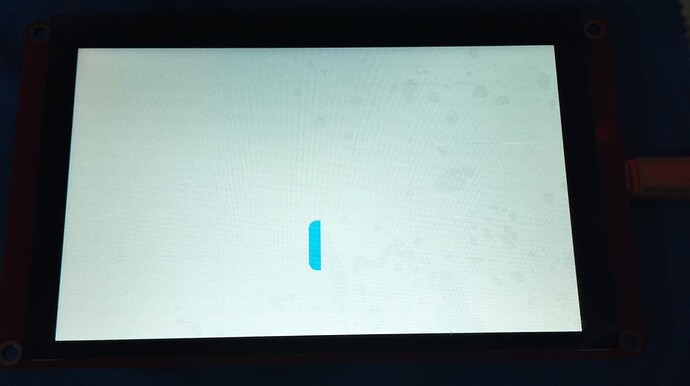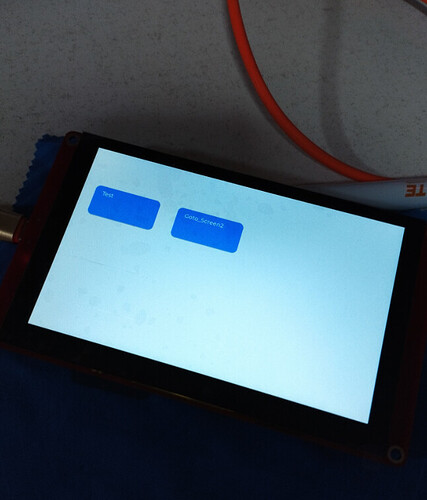I have a similar problem.
I bought a 5" elecrow display and the files they sent as an example.
They use very old libraries, which is Arduino_GFX
And nothing compiles, I can’t do a basic HelloWord with LVGL and this card.
I read this forum thread carefully and still haven’t been able to find a solution.
Can anybody help me.
My board is a small variation of the problem you are experiencing.


The declared display is the ILI6122 and ILI5960
This code below is the example provided by the manufacturer.
But it’s useless because it doesn’t compile and uses very outdated libraries.
#include <lvgl.h>
#include <demos/lv_demos.h>
//UI
#include "ui.h"
static int first_flag = 0;
extern int zero_clean;
extern int goto_widget_flag;
extern int bar_flag;
extern lv_obj_t * ui_MENU;
extern lv_obj_t * ui_TOUCH;
extern lv_obj_t * ui_JIAOZHUN;
extern lv_obj_t * ui_Label2;
static lv_obj_t * ui_Label;//TOUCH interface label
static lv_obj_t * ui_Label3;//TOUCH interface label3
static lv_obj_t * ui_Labe2;//Menu interface progress bar label
static lv_obj_t * bar;//Menu interface progress bar
#include <SPI.h>
SPIClass& spi = SPI;
uint16_t touchCalibration_x0 = 300, touchCalibration_x1 = 3600, touchCalibration_y0 = 300, touchCalibration_y1 = 3600;
uint8_t touchCalibration_rotate = 1, touchCalibration_invert_x = 2, touchCalibration_invert_y = 0;
static int val = 100;
static uint32_t screenWidth;
static uint32_t screenHeight;
static lv_disp_draw_buf_t draw_buf;
static lv_color_t disp_draw_buf[800 * 480 / 10];
static lv_disp_drv_t disp_drv;
#include <Ticker.h> //Call the ticker. H Library
Ticker ticker1;
#include <Arduino_GFX_Library.h>
#define TFT_BL 2
#define GFX_BL DF_GFX_BL // default backlight pin, you may replace DF_GFX_BL to actual backlight pin
/* More dev device declaration: https://github.com/moononournation/Arduino_GFX/wiki/Dev-Device-Declaration */
#if defined(DISPLAY_DEV_KIT)
Arduino_GFX *lcd = create_default_Arduino_GFX();
#else /* !defined(DISPLAY_DEV_KIT) */
Arduino_ESP32RGBPanel *bus = new Arduino_ESP32RGBPanel(
GFX_NOT_DEFINED /* CS */, GFX_NOT_DEFINED /* SCK */, GFX_NOT_DEFINED /* SDA */,
40 /* DE */, 41 /* VSYNC */, 39 /* HSYNC */, 0 /* PCLK */,
45 /* R0 */, 48 /* R1 */, 47 /* R2 */, 21 /* R3 */, 14 /* R4 */,
5 /* G0 */, 6 /* G1 */, 7 /* G2 */, 15 /* G3 */, 16 /* G4 */, 4 /* G5 */,
8 /* B0 */, 3 /* B1 */, 46 /* B2 */, 9 /* B3 */, 1 /* B4 */
);
Arduino_RPi_DPI_RGBPanel *lcd = new Arduino_RPi_DPI_RGBPanel(
bus,
800 /* width */, 0 /* hsync_polarity */, 210 /* hsync_front_porch */, 4 /* hsync_pulse_width */, 43 /* hsync_back_porch */,
480 /* height */, 0 /* vsync_polarity */, 22 /* vsync_front_porch */, 4 /* vsync_pulse_width */, 12 /* vsync_back_porch */,
1 /* pclk_active_neg */, 16000000 /* prefer_speed */, true /* auto_flush */);
#endif /* !defined(DISPLAY_DEV_KIT) */
#include "touch.h"
/* Display flushing */
void my_disp_flush(lv_disp_drv_t *disp, const lv_area_t *area, lv_color_t *color_p)
{
uint32_t w = (area->x2 - area->x1 + 1);
uint32_t h = (area->y2 - area->y1 + 1);
#if (LV_COLOR_16_SWAP != 0)
lcd->draw16bitBeRGBBitmap(area->x1, area->y1, (uint16_t *)&color_p->full, w, h);
#else
lcd->draw16bitRGBBitmap(area->x1, area->y1, (uint16_t *)&color_p->full, w, h);
#endif
lv_disp_flush_ready(disp);
}
void my_touchpad_read(lv_indev_drv_t *indev_driver, lv_indev_data_t *data)
{
if (touch_has_signal())
{
if (touch_touched())
{
data->state = LV_INDEV_STATE_PR;
/*Set the coordinates*/
data->point.x = touch_last_x;
data->point.y = touch_last_y;
Serial.print( "Data x :" );
Serial.println( touch_last_x );
Serial.print( "Data y :" );
Serial.println( touch_last_y );
}
else if (touch_released())
{
data->state = LV_INDEV_STATE_REL;
}
}
else
{
data->state = LV_INDEV_STATE_REL;
}
}
uint16_t calData[5] = { 190, 3679, 382, 3335, 0 };
void callback1() //Callback function
{
if (bar_flag == 6)
{
if (val > 1)
{
val--;
lv_bar_set_value(bar, val, LV_ANIM_OFF);
lv_label_set_text_fmt(ui_Labe2, "%d %%", val);
}
else
{
lv_obj_clear_flag(ui_touch, LV_OBJ_FLAG_CLICKABLE);
lv_label_set_text(ui_Labe2, "Loading");
delay(150);
val = 100;
bar_flag = 0; //Stop progress bar sign
goto_widget_flag = 1; //Enter the widget logo
}
}
}
void setup() {
// put your setup code here, to run once:
Serial.begin(9600); // Init Display
#ifdef TFT_BL
pinMode(TFT_BL, OUTPUT);
digitalWrite(TFT_BL, LOW);
#endif
lcd->begin();
lcd->fillScreen(BLACK);
lcd->setTextSize(2);
delay(200);
lv_init();
touch_init();
screenWidth = lcd->width();
screenHeight = lcd->height();
lv_disp_draw_buf_init(&draw_buf, disp_draw_buf, NULL, screenWidth * screenHeight / 10);
// lv_disp_draw_buf_init(&draw_buf, disp_draw_buf, NULL, 480 * 272 / 10);
/* Initialize the display */
lv_disp_drv_init(&disp_drv);
/* Change the following line to your display resolution */
disp_drv.hor_res = screenWidth;
disp_drv.ver_res = screenHeight;
disp_drv.flush_cb = my_disp_flush;
disp_drv.draw_buf = &draw_buf;
lv_disp_drv_register(&disp_drv);
/* Initialize the (dummy) input device driver */
static lv_indev_drv_t indev_drv;
lv_indev_drv_init(&indev_drv);
indev_drv.type = LV_INDEV_TYPE_POINTER;
indev_drv.read_cb = my_touchpad_read;
lv_indev_drv_register(&indev_drv);
#ifdef TFT_BL
digitalWrite(TFT_BL, HIGH);
#endif
ui_init();//Boot UI
while (1)
{
if (goto_widget_flag == 1)//Go to widget
{
if (ticker1.active() == true)
{
ticker1.detach();
}
goto_widget_flag = 0;
delay(300);
break;
}
if (goto_widget_flag == 3)//Go to the touch screen and close the progress bar thread first
{
bar_flag = 0; //Stop progress bar sign
if (ticker1.active() == true)
{
ticker1.detach();
}
if (first_flag == 0 || first_flag == 1)
{
label_xy();
first_flag = 2;
}
if (zero_clean == 1)
{
touch_last_x = 0;
touch_last_y = 0;
zero_clean = 0;
}
lv_label_set_text(ui_Label, "Touch Adjust:");
lv_label_set_text_fmt(ui_Label3, "%d %d", touch_last_x, touch_last_y); //Display touch information
}
if (goto_widget_flag == 4)//触摸界面返回到Menu界面,使进度条清零重启
{
val = 100;
delay(100);
ticker1.attach_ms(35, callback1);//每20ms调用callback1
goto_widget_flag = 0;
}
if (goto_widget_flag == 5) //Trigger Calibration Signal
{
lv_scr_load_anim(ui_touch_calibrate, LV_SCR_LOAD_ANIM_NONE, 0, 0, false);
lv_timer_handler();
lv_timer_handler();
delay(100);
touch_calibrate();//Touch Calibration
lv_scr_load_anim(ui_TOUCH, LV_SCR_LOAD_ANIM_NONE, 0, 0, false);
lv_timer_handler();
delay(100);
goto_widget_flag = 3; //Access to the touch screen logo
touch_last_x = 0;
touch_last_y = 0;
}
if (bar_flag == 6)//Runs the progress bar once when you first boot into the Menu screen, then stops running after that
{
if (first_flag == 0)
{
lv_example_bar();
ticker1.attach_ms(35, callback1);//每20ms调用callback1
first_flag = 1;
}
}
lv_timer_handler();
}
lcd->fillScreen(BLACK);
lv_demo_widgets();//Main UI
Serial.println( "Setup done" );
}
void loop() {
// put your main code here, to run repeatedly:
lv_timer_handler();
delay(5);
}
//Touch Label Controls
void label_xy()
{
ui_Label = lv_label_create(ui_TOUCH);
lv_obj_enable_style_refresh(true);
lv_obj_set_width(ui_Label, LV_SIZE_CONTENT); /// 1
lv_obj_set_height(ui_Label, LV_SIZE_CONTENT); /// 1
lv_obj_set_x(ui_Label, -55);
lv_obj_set_y(ui_Label, -40);
lv_obj_set_align(ui_Label, LV_ALIGN_CENTER);
lv_obj_set_style_text_color(ui_Label, lv_color_hex(0xFF0000), LV_PART_MAIN | LV_STATE_DEFAULT);
lv_obj_set_style_text_opa(ui_Label, 255, LV_PART_MAIN | LV_STATE_DEFAULT);
lv_obj_set_style_text_font(ui_Label, &lv_font_montserrat_24, LV_PART_MAIN | LV_STATE_DEFAULT);
ui_Label3 = lv_label_create(ui_TOUCH);
lv_obj_enable_style_refresh(true);
lv_obj_set_width(ui_Label3, LV_SIZE_CONTENT); /// 1
lv_obj_set_height(ui_Label3, LV_SIZE_CONTENT); /// 1
lv_obj_set_x(ui_Label3, 85);
lv_obj_set_y(ui_Label3, -40);
lv_obj_set_align(ui_Label3, LV_ALIGN_CENTER);
lv_obj_set_style_text_color(ui_Label3, lv_color_hex(0x00FF00), LV_PART_MAIN | LV_STATE_DEFAULT);
lv_obj_set_style_text_opa(ui_Label3, 255, LV_PART_MAIN | LV_STATE_DEFAULT);
lv_obj_set_style_text_font(ui_Label3, &lv_font_montserrat_24, LV_PART_MAIN | LV_STATE_DEFAULT);
}
//Progress bar control
void lv_example_bar(void)
{
//////////////////////////////
bar = lv_bar_create(ui_MENU);
lv_bar_set_value(bar, 0, LV_ANIM_OFF);
lv_obj_set_width(bar, 480);
lv_obj_set_height(bar, 25);
lv_obj_set_x(bar, 0);
lv_obj_set_y(bar, 175);
lv_obj_set_align(bar, LV_ALIGN_CENTER);
lv_obj_set_style_bg_img_src(bar, &ui_img_bar_800_01_png, LV_PART_MAIN | LV_STATE_DEFAULT);
lv_obj_set_style_bg_img_src(bar, &ui_img_bar_800_02_png, LV_PART_INDICATOR | LV_STATE_DEFAULT);
lv_obj_set_style_outline_color(bar, lv_color_hex(0x2D8812), LV_PART_INDICATOR | LV_STATE_DEFAULT);
lv_obj_set_style_outline_opa(bar, 255, LV_PART_INDICATOR | LV_STATE_DEFAULT);
//////////////////////
ui_Labe2 = lv_label_create(bar);//Creating Tags
lv_obj_set_style_text_color(ui_Labe2, lv_color_hex(0x09BEFB), LV_STATE_DEFAULT);
lv_label_set_text(ui_Labe2, "0%");
lv_obj_center(ui_Labe2);
}
#define Z_THRESHOLD 350 // Touch pressure threshold for validating touches
#define _RAWERR 20 // Deadband error allowed in successive position samples
void begin_touch_read_write(void) {
digitalWrite(38, HIGH); // Just in case it has been left low
spi.setFrequency(600000);
digitalWrite(38, LOW);
}
void end_touch_read_write(void) {
digitalWrite(38, HIGH); // Just in case it has been left low
spi.setFrequency(600000);
}
uint16_t getTouchRawZ(void) {
begin_touch_read_write();
// Z sample request
int16_t tz = 0xFFF;
spi.transfer(0xb0); // Start new Z1 conversion
tz += spi.transfer16(0xc0) >> 3; // Read Z1 and start Z2 conversion
tz -= spi.transfer16(0x00) >> 3; // Read Z2
end_touch_read_write();
return (uint16_t)tz;
}
uint8_t getTouchRaw(uint16_t *x, uint16_t *y) {
uint16_t tmp;
begin_touch_read_write();
// Start YP sample request for x position, read 4 times and keep last sample
spi.transfer(0xd0); // Start new YP conversion
spi.transfer(0); // Read first 8 bits
spi.transfer(0xd0); // Read last 8 bits and start new YP conversion
spi.transfer(0); // Read first 8 bits
spi.transfer(0xd0); // Read last 8 bits and start new YP conversion
spi.transfer(0); // Read first 8 bits
spi.transfer(0xd0); // Read last 8 bits and start new YP conversion
tmp = spi.transfer(0); // Read first 8 bits
tmp = tmp << 5;
tmp |= 0x1f & (spi.transfer(0x90) >> 3); // Read last 8 bits and start new XP conversion
*x = tmp;
// Start XP sample request for y position, read 4 times and keep last sample
spi.transfer(0); // Read first 8 bits
spi.transfer(0x90); // Read last 8 bits and start new XP conversion
spi.transfer(0); // Read first 8 bits
spi.transfer(0x90); // Read last 8 bits and start new XP conversion
spi.transfer(0); // Read first 8 bits
spi.transfer(0x90); // Read last 8 bits and start new XP conversion
tmp = spi.transfer(0); // Read first 8 bits
tmp = tmp << 5;
tmp |= 0x1f & (spi.transfer(0) >> 3); // Read last 8 bits
*y = tmp;
end_touch_read_write();
return true;
}
uint8_t validTouch(uint16_t *x, uint16_t *y, uint16_t threshold) {
uint16_t x_tmp, y_tmp, x_tmp2, y_tmp2;
// Wait until pressure stops increasing to debounce pressure
uint16_t z1 = 1;
uint16_t z2 = 0;
while (z1 > z2)
{
z2 = z1;
z1 = getTouchRawZ();
delay(1);
Serial.print("z1:");
Serial.println(z1);
}
if (z1 <= threshold) return false;
getTouchRaw(&x_tmp, &y_tmp);
delay(1); // Small delay to the next sample
if (getTouchRawZ() <= threshold) return false;
delay(2); // Small delay to the next sample
getTouchRaw(&x_tmp2, &y_tmp2);
if (abs(x_tmp - x_tmp2) > _RAWERR) return false;
if (abs(y_tmp - y_tmp2) > _RAWERR) return false;
*x = x_tmp;
*y = y_tmp;
return true;
}
void calibrateTouch(uint16_t *parameters, uint32_t color_fg, uint32_t color_bg, uint8_t size) {
int16_t values[] = {0, 0, 0, 0, 0, 0, 0, 0};
uint16_t x_tmp, y_tmp;
uint16_t _width = 800;
uint16_t _height = 480;
for (uint8_t i = 0; i < 4; i++) {
lcd->fillRect(0, 0, size + 1, size + 1, color_bg);
lcd->fillRect(0, _height - size - 1, size + 1, size + 1, color_bg);
lcd->fillRect(_width - size - 1, 0, size + 1, size + 1, color_bg);
lcd->fillRect(_width - size - 1, _height - size - 1, size + 1, size + 1, color_bg);
if (i == 5) break; // used to clear the arrows
switch (i) {
case 0: // up left
lcd->drawLine(0, 0, 0, size, color_fg);
lcd->drawLine(0, 0, size, 0, color_fg);
lcd->drawLine(0, 0, size , size, color_fg);
break;
case 1: // bot left
lcd->drawLine(0, _height - size - 1, 0, _height - 1, color_fg);
lcd->drawLine(0, _height - 1, size, _height - 1, color_fg);
lcd->drawLine(size, _height - size - 1, 0, _height - 1 , color_fg);
break;
case 2: // up right
lcd->drawLine(_width - size - 1, 0, _width - 1, 0, color_fg);
lcd->drawLine(_width - size - 1, size, _width - 1, 0, color_fg);
lcd->drawLine(_width - 1, size, _width - 1, 0, color_fg);
break;
case 3: // bot right
lcd->drawLine(_width - size - 1, _height - size - 1, _width - 1, _height - 1, color_fg);
lcd->drawLine(_width - 1, _height - 1 - size, _width - 1, _height - 1, color_fg);
lcd->drawLine(_width - 1 - size, _height - 1, _width - 1, _height - 1, color_fg);
break;
}
// user has to get the chance to release
if (i > 0) delay(1000);
for (uint8_t j = 0; j < 8; j++) {
while (touch_has_signal())
{
if (touch_touched())
{
Serial.print( "Data x :" );
Serial.println( touch_last_x );
Serial.print( "Data y :" );
Serial.println( touch_last_y );
break;
}
}
}
}
}
void touch_calibrate()//screen calibration
{
uint16_t calData[5];
uint8_t calDataOK = 0;
Serial.println("screen calibration");
//校准
Serial.println("Touch corners as directed");
lv_timer_handler();
calibrateTouch(calData, MAGENTA, BLACK, 17);
Serial.println("calibrateTouch(calData, TFT_MAGENTA, TFT_BLACK, 15)");
Serial.println(); Serial.println();
Serial.println("// Use this calibration code in setup():.");
Serial.print("uint16_t calData[5] = ");
Serial.print("{ ");
for (uint8_t i = 0; i < 5; i++)
{
Serial.print(calData[i]);
if (i < 4) Serial.print(", ");
}
Serial.println(" };");
}
void setTouch(uint16_t *parameters) {
touchCalibration_x0 = parameters[0];
touchCalibration_x1 = parameters[1];
touchCalibration_y0 = parameters[2];
touchCalibration_y1 = parameters[3];
if (touchCalibration_x0 == 0) touchCalibration_x0 = 1;
if (touchCalibration_x1 == 0) touchCalibration_x1 = 1;
if (touchCalibration_y0 == 0) touchCalibration_y0 = 1;
if (touchCalibration_y1 == 0) touchCalibration_y1 = 1;
touchCalibration_rotate = parameters[4] & 0x01;
touchCalibration_invert_x = parameters[4] & 0x02;
touchCalibration_invert_y = parameters[4] & 0x04;
}
Does anyone have an idea what could be happening?
Which path to follow?
@Xylopyrographer and @Yuri_Alves_Bordin
(Fala Youri me ajuda, por favor). Tamos de boa



